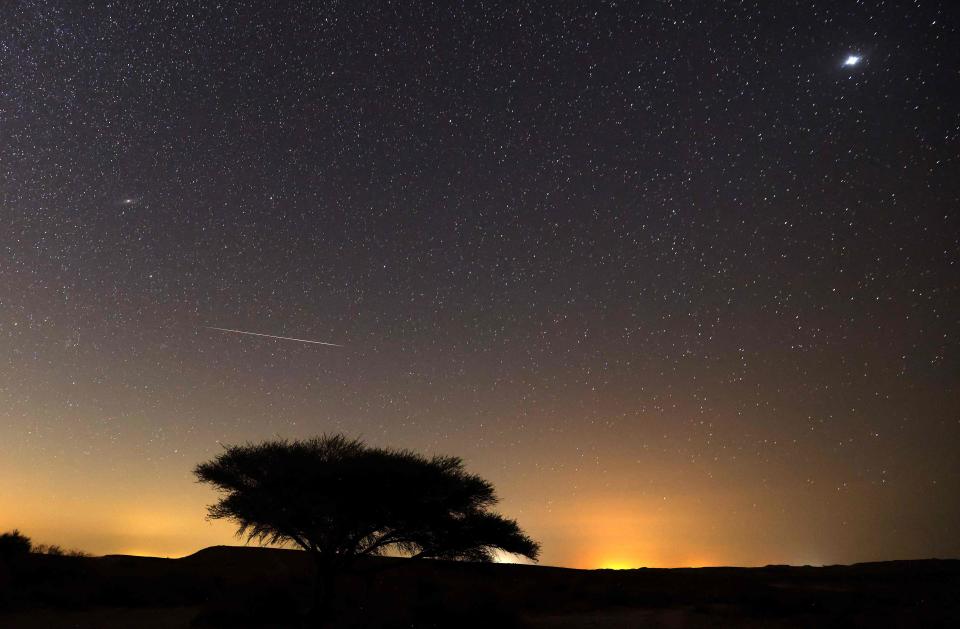NASA's 'Meteor Guy' explains the meteor showers coming in 2024
While Rochesterians were caught up in the understandable excitement of clear viewing of the Northern Lights beginning on May 10, it’s just the latest celestial happening of note in 2024.
The solar eclipse, while disappointing due to local cloud cover, captured imaginations and whipped up a lot of local interest. And prior to Northern Lights viewing, the byproduct of coronal mass ejections from massive sunspots, the Eta Aquariid meteor shower enjoyed an above-average year with double the typical rate, peaking around May 5.
What is a meteor shower?
Meteors are rock and ice debris ejected from comets and asteroids in orbit around the sun which burn up in earth’s upper atmosphere, giving off streaks of light colloquially known as shooting stars. Meteor showers happen at regular intervals because comets orbit the sun, though in a highly elliptical pattern as opposed to the rounder orbit of planets. Each time the orbit of a comet or asteroid and the earth cross, the planet is hit by debris, the vast majority of which never reaches the ground.
Meteor showers are named for the constellation closest to the point they appear to originate from in the night sky, such as Perseus for the Perseids and Gemini for the Geminids.
2024 meteor showers of note: Yellow fireball
There are several remaining meteor showers visible from the Northern Hemisphere this year, though only two are worthy of the average meteor observer's time, according to Bill Cooke, NASA Meteoroid Environments Office lead.
“The simple fact of the matter is that in an average year, the only showers with rates good enough to go and take a look are the Perseids and Geminids,” said Cooke.
While Eta Aquariid is still happening, the rate has declined to the point it is essentially done, with meteors visible only every 30 minutes or so. That’s a radical departure from what viewers can expect when the Perseid meteor shower peaks the night of Aug. 11, where a moon in early phase will create conditions to see meteor showers as frequently as one a minute in light pollution-free evening skies.
The shower features a nice yellow fireball during the shower, which should create a very good show, Cooke said.

“My recommendation is people go out after midnight on the night of Aug. 11, the early morning hours of Aug. 12,” he said. “Get comfortable, life flat on your back, look straight up and enjoy the Perseids.”
The Geminids won’t peak until Dec. 13 this year and the moon will be near full, creating more challenging viewing conditions. The brighter moon means the viewing rate for meteors during Geminids will be closer to one every three to five minutes, without other light aside from the sun.
“The sky is going to be bright; you’re going to lose a lot of faint meteors,” Cooke said. “... If the moon wasn’t there, the Geminids would put on just as good a show, if not a better show, than the Perseids, but the moon is there.”
Tips for viewing meteor showers
Meteors can be seen with the naked eye, meaning there’s no need for special equipment to see shooting stars. The best place to view these nighttime splashes of light is in rural areas, away from light pollution.
“If you’re in a suburb, you know, you may see one every five to 10 minutes, so those lights will cut down the rates like crazy,” Cooke said. “It’ll wash out the fainter meteors, and, of course, there are a lot more small meteors than big ones.”
As a result, Cooke recommends finding the darkest place they can when observing a meteor shower.
And meteor view-ruining light sources don’t just include streetlights. Cooke said a modern source affecting meteor viewing travels in most people’s pocket: their smartphone.
“People are very connected these days,” he said. “But unfortunately, the devices we use have bright screens that can trash your night vision.”
While the Perseids can be viewed by simply laying on the ground in the summertime, Cooke recommended lots of layers and laying on a cot or sleeping bag for the Geminid shower to stay warm.
Double-checking the peak dates for meteor showers is also important. While the showers fall in the same month each year, the peak date can vary year-to-year and more generic tables or outdated information could have you looking to the skies on a non-peak night.
Looking ahead: How hot will summer be in New York? Here's what AccuWeather predicts
Are people more interested in space this year?
With the most significant U.S. solar eclipse having happened in April and the recent aurora catching major attention, it's been a banner year for celestial viewings. The attention for meteor showers persists annually, Cooke said, because people are always interested in things that fall from the sky.
“It’s going to be a pretty normal year for meteor showers, but people are always interested in the Perseids and Geminids, particularly the Perseids because it occurs at a warm time of year,” he said.
The allure of wishing on a falling star persists and with a little planning, you can experience meteor showers in their full glory later this year.
— Steve Howe covers weather, climate and lake issues for the Democrat and Chronicle and wanted to be an ornithologist when he was a kid. An RIT graduate, he returned to Rochester after working around the state and in Utah. Share with him at showe@gannett.com.
This article originally appeared on Rochester Democrat and Chronicle: When is the next meteor shower? 2024 information for Perseids, Geminids

